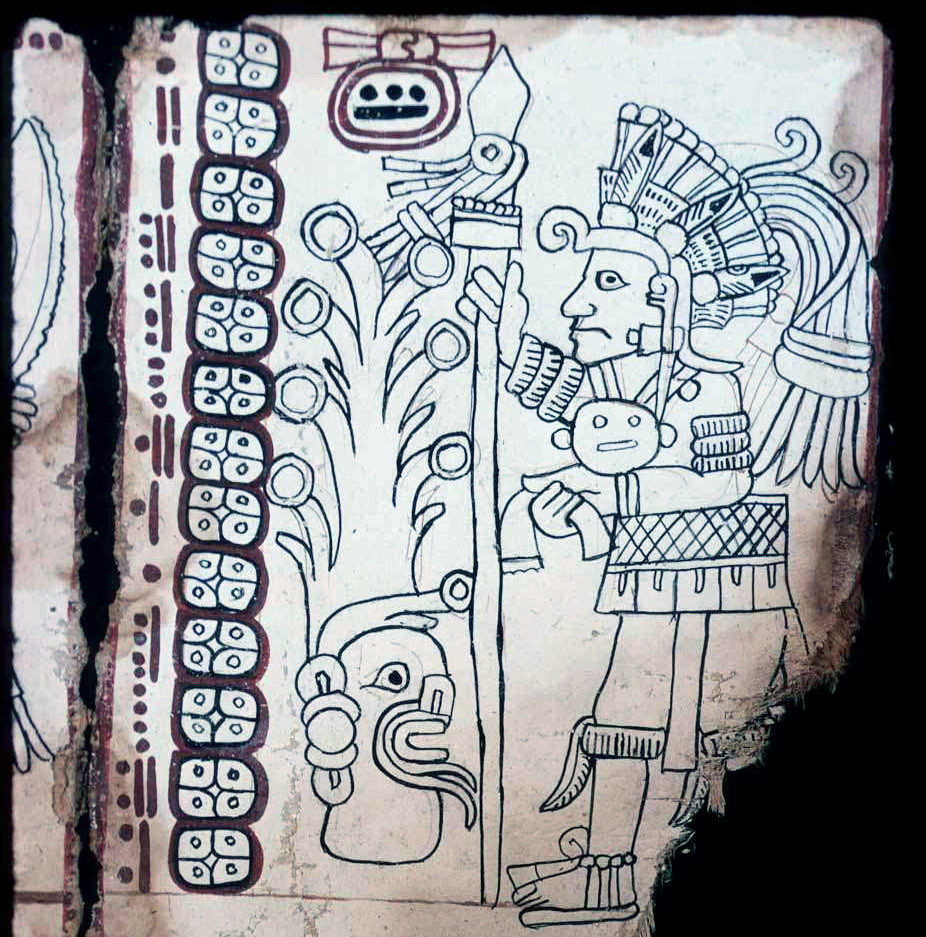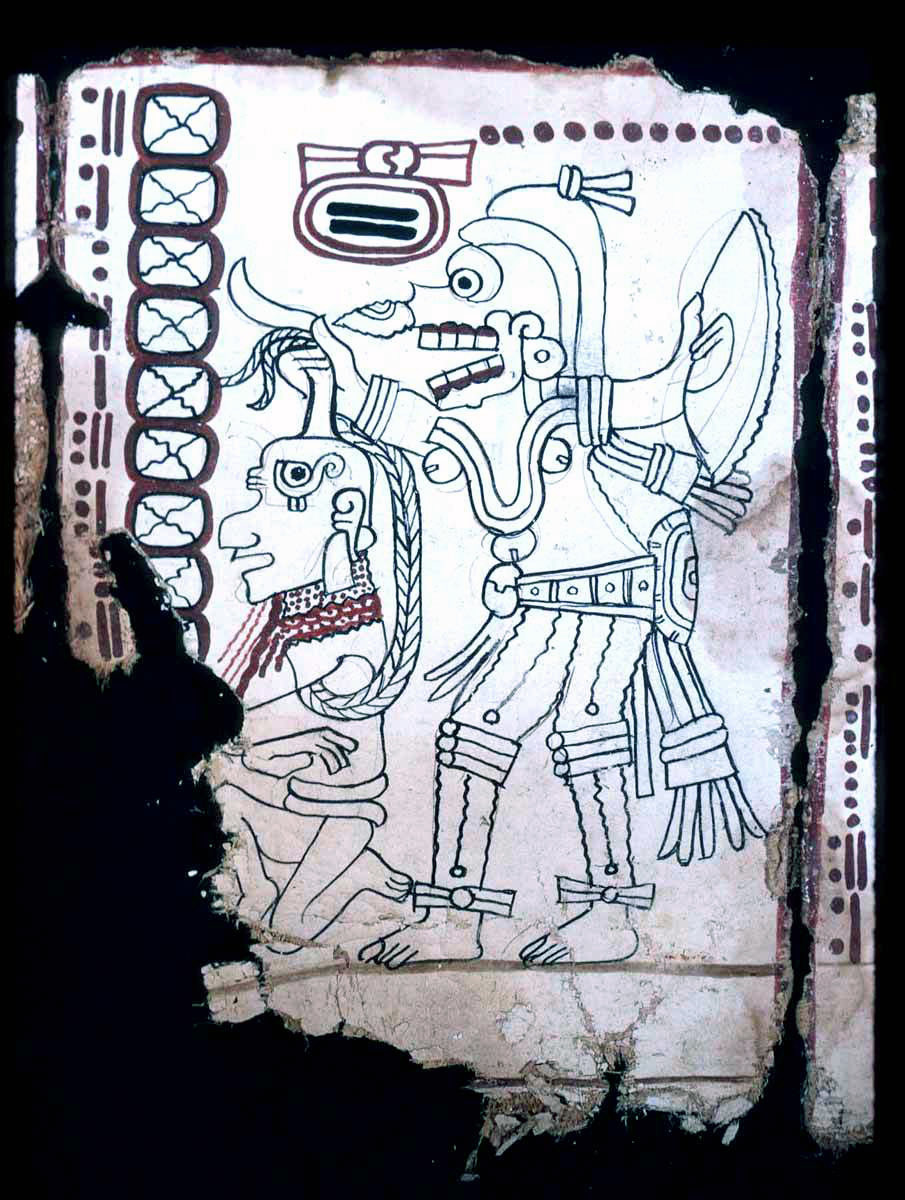Proved the authenticity of the Codex Grolier - the fourth surviving Mayan Code

Page 7 Grolier Codex on paper made from ficus bark. It shows a figure in a headdress with feathers. Headgear equates the figure to the gods from the tables of the planet Venus in the Dresden Codex. Before him stands the bearded head of God C, presumably associated with the Polar Star, from which the plant grows with buds in the form of discs. Scanned image: Codex Grolier
In the 16th century, conquistandors and Catholic missionaries did much to destroy the extensive Mayan priestly and government libraries. In general, they succeeded. Of the hundreds of Native American books, only three have survived to date (they are called “codes”). These unique artifacts are named after the cities in which museums they are kept: the Dresden, Paris and Madrid Mayan codes. Of these, only the Dresden Codex is fully preserved. Scientists are still studying the astronomical records in it, compiled from the results of Mayan observations of the stars for many centuries.
In 1971, there was a real sensation in the Maya community of experts. Mexican collector Jose Saenz (José Saenz) decided to show the world his main treasure - the fourth preserved Mayan code, which he allegedly bought in 1965 from a group of unknown persons. On April 20, 1971, the artifact was put on public display in the gentleman's club, Grolier , from which the codex was given the name.
Naturally, the story caused great doubts. Jose Saenz said that he was taken to an unknown place, where unknown persons offered to buy several artifacts, including pages of this code, allegedly found recently in a cave in the Mexican mountains of the Sierra Madre de Chiapas.
')
The Code consists of 11 damaged paper fragments (from the bark of different types of ficus), approximately 18 × 12.5 cm in size; images on one side of sheets only. It is assumed that the original consisted of at least 20 sheets.
As is known, the Mayans had a painful passion for the stars and even the location of the cities was chosen in accordance with the star scheme . According to the contents of the found Codex Grolley echoes the tables of Venus in the Dresden Codex. It contains images of the same gods and astrological data corresponding to the phases of Venus in a simplified dating according to the Mayan calendar.
Mayan dating example
Time is counted in cycles of 13 baktuns (13 × 144,000 days).
The starting date of the current cycle is 0.0.0.0.0, 4 Ahau, 8 Kumhu
10/24/2004 = 12.19.11.13.0, 1 Ahau, 3 Sac (correlation 584,283)
10.24.2004 = 12.19.11.12.18, 12 Etsnab, 1 Sak (correlation 584 285)
The experts immediately questioned the authenticity of the Grolier Codex. This can be understood if we take into account the astronomical amount in which this document could be evaluated at auction. Probably we can talk about tens or hundreds of millions of dollars.
Carried out radiocarbon analysis allowed dating the manuscript to 1230, but did not convince skeptics. They continued to claim that the manuscript could have been made on genuine paper sheets found at the excavations.
Re-examination of 2007 yielded contradictory results.
And only now, in 2016, scientists can put an end to this dispute (although they may not). The authenticity of the manuscript was confirmed with a high degree of accuracy by a group of reputable scientists from Brown University, Harvard University and University of California at Riverside (all of them are from the USA). Scientists have conducted a thorough analysis of all previous examinations and scientific research on this topic and with all authority have concluded that the manuscript is authentic.
The authority of the scientists who subscribed to this work suggests that scientific consensus has been reached on the authenticity of the Grolier Code. It really is the fourth surviving Mayan code.
The group, led by Professor Stephen Houston (Brown University) at Brown University, carefully studied the origin of the manuscript, the characteristics and style of the iconography, the nature and significance of the tables of Venus, scientific data, including radiocarbon analysis, as well as the physical characteristics of the code itself - how it was made , from which paper, how inscriptions were made. They concluded that, according to all characteristics, the code is probably genuine. The authors of the scientific work list in detail all the arguments of skeptics regarding the authenticity of the code, and respond reasonably to every argument.
According to them, discrepancies with the Dresden Code (for example, different patterns on the legs of the god of death) should not be considered proof of forgery. Just the old codes, including the Dresden Codex, were found earlier, which gave them a canonical status. At the same time, radiocarbon analysis shows that the Grolier Codex was written earlier than the Dresden Codex.
The paper from the ficus bark, the thin red lines of the sketch under the drawings, as well as the blue Maya pigment inks are completely authentic, scientists believe. They list the list of knowledge that a clerk should have (or guessed) in order to reliably forge a document in the mid-1960s. The list included the information that became known to scientists only in the last 45 years after the discovery of the code. This list is so large that it can be considered as “prohibiting”, that is, practically impossible from the point of view of probability theory. It is incredible that the clerk guessed all these details.
For example, the synthesis of blue ink, similar to Maya ink, was conducted by Mexican scientists only in the 1980s.
The pages of the Codex Grolier depict the Mayan everyday gods who accompanied them in everyday life: these are the gods of the Sun, death, lightning, and others. Although all of them, according to Maya beliefs, do the will of the stars, and specifically, the will of the "star" of Venus. In the Dresden and Madrid codes, a greater number of diverse gods are presented, but in the Codex Grolier only the basic set.

Page 6 of the Grolier Codex. The god of death (god A), in a simple headdress with a knife in his hand, had just decapitated another god, from whose neck blood flows. Knife for beheading such a form with the god of death is found on one of the frescos of the Temple of the Warriors in Chichen Itza . Scanned image: Codex Grolier
According to scientists, Codex Grolier is predictive, not narrative. It rather describes the events that should occur in the future, rather than past events. Judging by the dates, the code could be used as a desk calendar for priests for 104 years after the date of creation.
The Codex Grolier is now stored in the National Museum of Anthropology in Mexico City. He is not exposed to public display. This is probably due to the scandalous history that accompanied its discovery, and doubts about the authenticity of the document. Now that these doubts are largely dispelled, a unique artifact can attract more attention from the public and the scientific community.
A group of scientists published a 50-page scientific article analyzing the results of expert examinations in the last volume of Maya Archaeology .
Source: https://habr.com/ru/post/397563/
All Articles